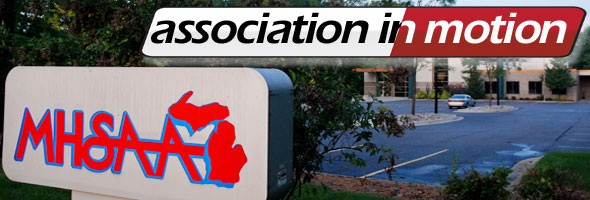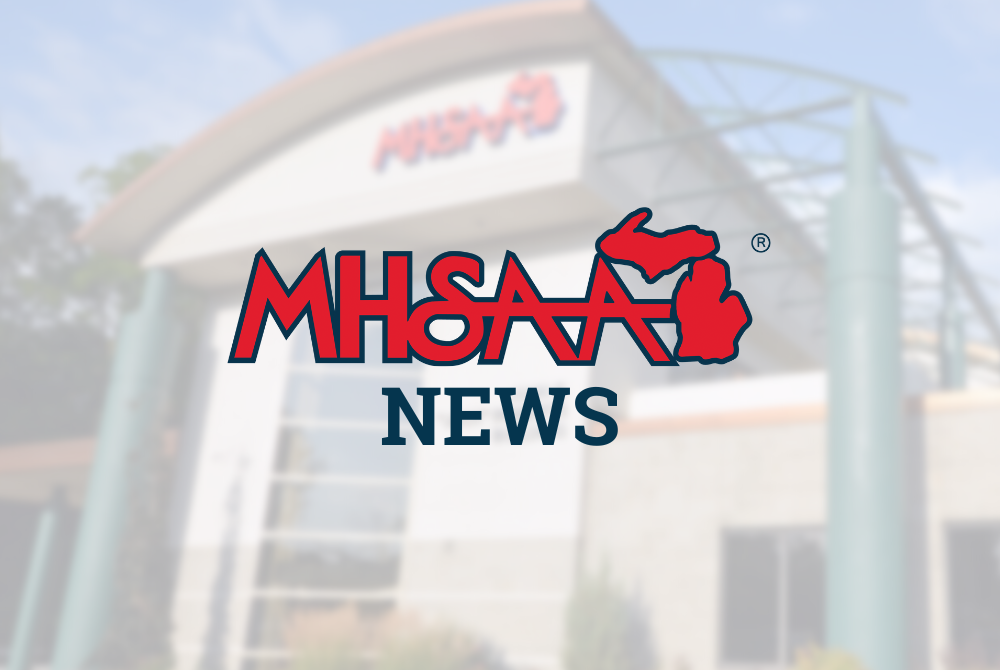
Coaches Get U-M Concussion Training
July 24, 2012
Already administering a strong set of protocols addressing the removal and return to play of young athletes suspected of sustaining concussions in competition, the Michigan High School Athletic Association is further ramping up its concussion education efforts of coaches, student-athletes and parents as the 2012-13 school year approaches.
In partnership with the University of Michigan’s NeuroSport and the Pediatric Trauma Program at C.S. Mott Children’s Hospital, required online rules meetings for coaches and officials will include an education component illustrating the serious nature of concussions; recognition of the signs and symptoms; a review of return to play protocols; applicable MHSAA regulations; and downloadable co-branded resources from NeuroSport, as well as materials produced by a joint effort of the Brian Injury Association of Michigan, the Detroit Lions, the Center for Disease Control and the MHSAA.
This is the second year the MHSAA has included concussion education in its online rules meetings, which are annually viewed by nearly 20,000 coaches and game officials. This year, the Michigan NeuroSport Concussion Education - High School Coach edition, endorsed by the American Academy of Neurology last fall, has been modified for the MHSAA audience. The MHSAA will also promote the availability of the NeuroSport concussion education modules offered specifically for parents and coaches.
“These educational efforts, coupled with protocols addressing concussions when they take place on the field of play, put our schools in the best possible position to minimize the risk to young people,” said John E. “Jack” Roberts, executive director of the MHSAA. “We’re pleased to have our new partnership with University of Michigan NeuroSport and our ongoing partnership with the Brian Injury Association of Michigan which put our state at the forefront of addressing the critical health issue for interscholastic athletes.”
Roberts added that the same educational materials the Association has co-branded with its partners will also be used to help raise concussion awareness in other youth sports by other sponsors in the state.
“We are proud to partner with MHSAA and bring the most up-to-date concussion education to those on the frontline of athletics. Education is a vital component to improving player safety,” says Amy Teddy, injury prevention program manager at C.S. Mott Children’s Hospital. “We believe that ‘It takes a team to keep concussions on the sidelines.’ Parents, coaches, teammates, officials and athletic trainers all have a role in protecting athletes from serious injury.
“In addition to our coach modules, we recently launched our parent edition to help another member of the ‘team’ better recognize and understand concussion.” added Teddy, who also is director of education for Michigan Neurosport.
The NeuroSport online programs for parents, high school coaches and youth sports coaches is now available at http://www.MichiganNeuroSport.com. An online program for athletes will be available soon.
NeuroSport has also produced a 60-second public service announcement in which one of the state’s all-time winningest football coaches – John Herrington of Farmington Hills Harrison – talks about concussions. This video, along with a 30-second PSA recently updated by the MHSAA, “No Such Thing As Just Getting Your Bell Rung,” will be made available to media outlets in time for the coming sports season, and will be shown during MHSAA programming online and on cable television.

Survey Shows Small but Steady Rise of Multi-Sport Participation at MHSAA High Schools
By
Geoff Kimmerly
MHSAA.com senior editor
December 16, 2025
The Michigan High School Athletic Association’s seventh Multi-Sport Participation Survey, conducted last spring for the 2024-25 school year, showed small but continuing growth of multi-sport participation among athletes at member high schools.
The annual Multi-Sport Participation Survey was inspired by the MHSAA’s Task Force on Multi-Sport Participation, which was appointed in 2016 to study early and intense sport specialization – a serious issue related to health and safety at all levels of youth sports – and to promote multi-sport participation as a way to help stave off overuse injuries and burnout among athletes that have been tied to chronic injuries and health-related problems later in life.
The 2024-25 Multi-Sport Participation Survey received responses from 82.7 percent of member high schools and showed 45.4 percent of athletes at those MHSAA member high schools participating in two or more sports, an increase of six tenths of a percent from 2023-24. Multi-sport participation has shown increases every year of the study – and a combined increase of 2.6 percent since the first study after the 2017-18 school year.
For 2024-25, 47.8 percent of male athletes and 42.3 percent of female athletes played multiple sports. The percentage of multi-sport athletes remains inversely proportional to schools’ enrollments, as Class D schools again enjoyed the highest percentage of multi-sport athletes at 63.1 percent, followed by Class C schools (59.6), Class B (49.3) and Class A (38.5).
All four enrollment classifications also continued to show increasing multi-sport participation. Class A multi-sport participation increased three tenths of a percent from 2023-24 and is now up 2.6 percent from 2017-18 survey results. Class B increased 1.3 percent from the previous year and is also up 2.6 percent since 2017-18. Class C multi-sport participation grew two tenths of a percent over the previous year and sits 4.4 percent higher than the first study, and Class D multi-sport participation in 2024-25 remained the same as in 2023-24 and has grown five percent over the last seven years.
The MHSAA Task Force also recommended measuring multi-sport participation in MHSAA member schools to recognize “achievers” – that is, schools that surpass the norm.
Battle Creek Harper Creek, Detroit Cody and Grand Rapids Northview have appeared among the top 10 percent of their respective Classes six of the seven years the survey has been conducted. Four more schools have appeared among the top 10 percent of their Classes five of the seven years: Decatur, East Grand Rapids, Manton and Warren Michigan Collegiate. Detroit Douglass, Parma Western and Lake Leelanau St. Mary have appeared among the top 10 percent of their Classes four times apiece.
In Class A, Grand Rapids Northview (79.4 percent) posted the highest percentage of multi-sport athletes for 2024-25, followed by Macomb L’Anse Creuse North (70 percent), Detroit Cass Tech (61.4) and Sterling Heights Stevenson (60.7) also reporting at least 60 percent.
Warren Michigan Collegiate paced Class B schools with 91.3 percent of athletes playing multiple sports, followed by Tecumseh (77.7), Yale (76.6), Detroit Cody (71.4), Battle Creek Harper Creek (71.3) and Manistee (70.1). Class C saw six schools reach 80 percent for the second-straight school year, led by Jackson Lumen Christi (97.6 percent), Martin (89.7), Bad Axe (89.3), Cass City (88.6), Center Line Prep Academy (83.6) and Decatur (82.3).
Watervliet Grace Christian topped the Class D list at 93.8 percent of athletes participating in multiple sports. Next were Watersmeet (89.7), Lake Leelanau St. Mary (88.2), Detroit Douglass (87.8), Vestaburg (87.7) and Portland St. Patrick (87.3).
The full summary report on the Multi-Sport Participation Survey is available on the “Multi-Sports Benefits” page.

